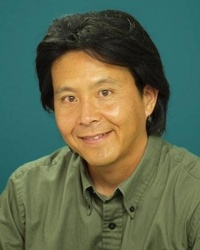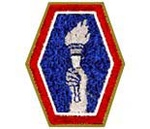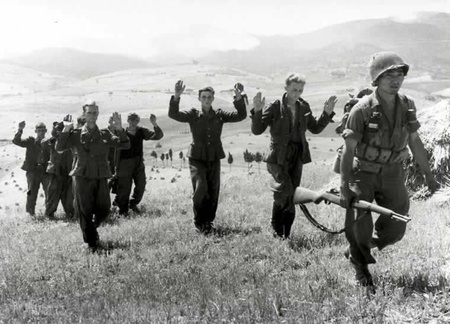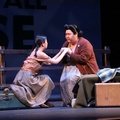Their families were in concentration camps. They were designated enemy aliens. Their rights as American citizens were denied. “The government did us a big wrong and we had to prove how wrong they were,” said Frank Shimada. “The only way to prove it was by going to war and laying our life on the line.” Shimada, who had been interned at Heart Mountain, Wyoming is one of more than a dozen members of the 442nd Regimental Combat Team who appear in the documentary, “Valor With Honor” by Burt Takeuchi. The feature-length film, to be screened at JANM on February 5, at 2pm, reveals the steep price these World War II veterans paid to prove their loyalty to America.
Burt Takeuchi, a Los Angeles born Sansei, first learned about the 442nd as a boy in elementary school. “My neighbor Nob Shimotsuka was a member of the 442nd and loaned me his photo albums to take to school for show and tell,” recalled Burt. His interest in this heroic regiment increased through the years as he met and became friends with other Nisei vets. Burt thought about how best to preserve and tell the story of the most decorated regiment—21 Medals of Honor, and more than 500 Silver Stars and 9000 Purple Hearts—in the history of the United States armed forces.
Then Burt lost several of his friends. “The fact that the vets were passing away at an alarming rate convinced me to create a documentary on these fascinating stories I heard over the years,” he wrote. “I wanted to make a film on the 442nd but did not have the skill at the time to produce one.”
Burt graduated in 1995 from San Jose State University with a degree in Biology, not the standard filmmaker credential. He had, however, taken courses in oral history at Cal State Long Beach. In addition he had worked as an extra and an actor in several films. “One advantage of working on a Hollywood set,” shared Burt, “is that you can learn from the best (actors, technicians, directors, etc.) The editing and camera were self taught.” Burt certainly applied those skills effectively.
“Valor With Honor” unfolds in a straightforward manner, without editorializing, voiceovers, or extended historical context. Instead, the subjects speak, one after the other, about their experiences. Each person is filmed seated, at close range, giving viewers the sensation that they are guests, pulling up a chair in a living room to listen to stories that are as gripping now as they were more than sixty years ago. Burt showed “that these stories were first-hand and not all second-hand stories.”
Many of the interviewees were close comrades that Burt initially located through the JA community. “If you notice, some the vets interviewed were in the same platoons or companies. In some of the scenes in the film, the vets are recalling fighting very close to each other. Maybe 25 yards or less,” wrote Burt. “So each vet had a few friends from the war to contact. The idea to have vets from the same unit comment on specific historical events worked out well for the film.”
After a preliminary phone interview, Burt then filmed each subject, starting with a list of prepared questions. However, he “also let the interviewees go if they had something important to say” resulting in many hours of taped interviews. “Since I had so much footage,” explained Burt, “I wanted to show as much as possible and decided to not use a narrator to carry the story. This was risky since I could lose the audience without careful editing. I wanted to show the stories the way I heard them: raw, gritty, and not polished. War is horrible and I didn’t want to gloss over that aspect of the interviews.”
The terrible conditions endured and the impossible odds faced are eloquently described by these veterans of the 442nd who lived the unit’s motto, “Go For Broke.” Cold and hungry before the Battle of Bruyeres in the Vosges Mountains of northeastern France, Al Takahashi of the 100th battalion described a rare treat of musubi and chicken. “I was ready to fight any German after that musubi and chicken.” His unit fought a fierce battle with German soldiers, earning a Presidential Unit Citation for liberating the townspeople of Bruyeres.
One of the most dramatic accomplishments of the 442nd was the rescue of the “Lost Battalion,” the 141st Infantry Division. Two-hundred-thirty soldiers, formerly from the Texas National Guard, were surrounded by German troops. After two failed attempts to rescue the 141st, Major General John Dahlquist sent the 442nd into treacherous conditions. The “Go For Broke” unit managed to break through enemy defenses in five days but in doing so, suffered enormous losses totaling more than 800 casualties.
“Valor With Honor” includes an interview of Al Tortolano, a member of the 141st Regiment, saved by the 442nd. “That’s what I call loyalty to a country,” he said. “For what they went through and for them to come as a unit and fight for a country like they did…how can you thank them enough?” Another Lost Battalion veteran, Irv Blonder, noted that the 442nd never received their due. “We weren’t the heroes of the Lost Battalion, they were.”
The high number of casualties suffered by the 442nd illustrated both the extreme bravery of this unit but also, perhaps, the pervasive racism that the unit endured. Many veterans believe General Dahlquist saw the Japanese American unit as expendable “cannon fodder.” The veterans on “Valor With Honor” described racism before and during their military service but also faced discrimination after they returned home. Some of these brave soldiers had no home to return to, and most faced storefronts with “No Japs Allowed” signage posted. But Lawson Sakai, in the film, noted how the Issei pioneers had been treated badly and that the 442nd “needed to right that. The world has opened up... the Sansei and Yonsei have to remember that. It would not be like it is today,” without the battles the 442nd fought on and off the battlefield.
“Valor With Honor” preserves vivid first-hand accounts of fierce battles, dramatic rescues and the liberation of Jewish prisoners at Dachau. “I wanted to show the Nisei vets in a light that few have seen before. You hear about their accomplishments on the battlefield but not how they felt about their personal experiences,” wrote Burt. “It’s also a tribute to our vets who where willing to sacrifice their lives to a country that turned its back on them.”
Burt Takeuchi is by no means finished with this subject. “I am interested in producing an independent dramatic film on the 442nd but there is talk of a film in Hollywood also.” Perhaps he’ll be behind the camera as well as in front of it.
* * *
Screening “Valor With Honor” at the Japanese American National Museum
Saturday, February 5, 2010 at 2:00pm.
Filmmaker Burt Takeuchi will be available for Q&A following the screening.
The official website: Valor With Honor
© 2011 Japanese American National Museum








